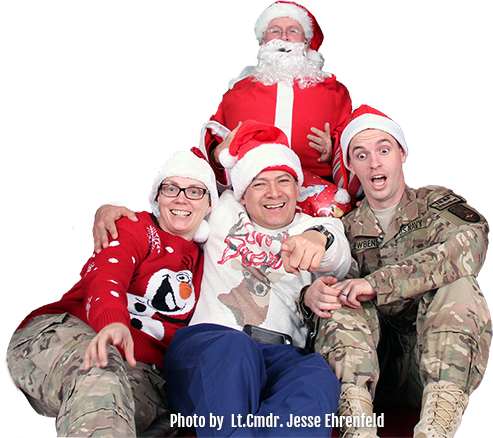Meet Your Military
- Details
- Hits: 12211
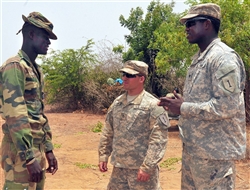 PHOTO: Army Spc. Lassana Traore, right, translates during a conversation between Army Pfc. Cody Anderson, center, and a Senegalese soldier during exercise Western Accord 14 at Camp Thies, Senegal, June 25, 2014. U.S. Army photo by Sgt. Takita Lawery THIES, Senegal – After joining the U.S. Army two years ago, Spc. Lassana Traore, a food service specialist with 1st Infantry Division’s 4th Infantry Brigade Combat Team, couldn’t have imagined he would find himself back in his native land of Senegal as an Army translator for Exercise Western Accord 14. Staff Sgt. Murquitte Wingfield, food service noncommissioned officer in charge, Company E, 1st Battalion, 28th Infantry Regiment, said Traore’s a “super soldier” who is always motivated to do more than what is asked or expected of him. "It is a great learning experience for him to be serving his native country and the U.S. Army," Wingfield said.
PHOTO: Army Spc. Lassana Traore, right, translates during a conversation between Army Pfc. Cody Anderson, center, and a Senegalese soldier during exercise Western Accord 14 at Camp Thies, Senegal, June 25, 2014. U.S. Army photo by Sgt. Takita Lawery THIES, Senegal – After joining the U.S. Army two years ago, Spc. Lassana Traore, a food service specialist with 1st Infantry Division’s 4th Infantry Brigade Combat Team, couldn’t have imagined he would find himself back in his native land of Senegal as an Army translator for Exercise Western Accord 14. Staff Sgt. Murquitte Wingfield, food service noncommissioned officer in charge, Company E, 1st Battalion, 28th Infantry Regiment, said Traore’s a “super soldier” who is always motivated to do more than what is asked or expected of him. "It is a great learning experience for him to be serving his native country and the U.S. Army," Wingfield said.
"I think he will gain a lot of knowledge from interacting with both nations simultaneously during the exercise." Traore grew-up in Pikine, a small city outside of Dakar, Senegal, with his parents, four brothers and three sisters. He graduated from Seydou Nourou Tall, a multigrade school, in 2000. Following an injury to his leg that stopped him from playing professional soccer, Traore said, he decided to travel to France to attend college and study business management. He later traveled to Italy to help in running his father's fishing company, and it was there where he met his wife, who also serves in the Army. Traore joined the Army in 2012, and chose to be a cook because choices were limited for him at the time. “I actually enjoy doing my job," he added. "And now, I am happy to be here, because I can serve both my countries at the same time. "Traore's duties during the exercise were limited at first to the food service team. But things quickly changed when his unit hit the ground in Senegal.
In addition to working in the dining facility, he soon was translating for various African nations throughout Camp Thies. The 32-year-old said helping soldiers to overcome language barriers has been one of his favorite parts of Western Accord 14 was. Knowing he helped soldiers better comprehend the training they received so they could apply it to what they already knew was what he enjoyed most about the experience, he added.
Read more: Meet Your Military: Soldier Born in Senegal Returns for Exercise
- Details
- Hits: 2323
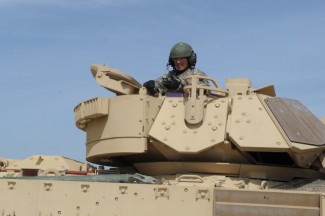 PHOTO: Army Maj. Chrissy Cook sits at the helm of her Bradley fighting vehicle during a media opportunity at Fort Hood, Texas, July 7, 2014. U.S. Army photo by Heather GrahamFORT HOOD, Texas – Army Maj. Chrissy Cook made history in the 1st Cavalry Division last month when she led her Bradley fighting vehicle crew to "Top Gun" status during gunnery exercise, making her the first female Bradley commander to do so. In June, Cook led her crew to her battalion’s "Top Gun" title in a gunnery exercise. Ashley Cook, an engineer officer and for 3rd Brigade Engineer Battalion, 3rd Brigade Combat Team, 1st Cavalry Division, led her crew to a top score of 835 with nine of 10 engagements as the Army continues to open doors to women in direct combat roles. The engineer branch has long been open to women. "We are all trained the same," Cook said, noting that female engineers were not authorized to go into a combat arms unit until reaching the rank of major. "That's been open for awhile," she added. When her unit's Bradley gunnery came up, Cook filled in for her battalion commander. "I just happened to be in the right place at the right time," she said. She and her crew trained for six months -- mostly on nights and weekends, because of Cook's work commitments. "We went through the same things as other crews," Cook said.
PHOTO: Army Maj. Chrissy Cook sits at the helm of her Bradley fighting vehicle during a media opportunity at Fort Hood, Texas, July 7, 2014. U.S. Army photo by Heather GrahamFORT HOOD, Texas – Army Maj. Chrissy Cook made history in the 1st Cavalry Division last month when she led her Bradley fighting vehicle crew to "Top Gun" status during gunnery exercise, making her the first female Bradley commander to do so. In June, Cook led her crew to her battalion’s "Top Gun" title in a gunnery exercise. Ashley Cook, an engineer officer and for 3rd Brigade Engineer Battalion, 3rd Brigade Combat Team, 1st Cavalry Division, led her crew to a top score of 835 with nine of 10 engagements as the Army continues to open doors to women in direct combat roles. The engineer branch has long been open to women. "We are all trained the same," Cook said, noting that female engineers were not authorized to go into a combat arms unit until reaching the rank of major. "That's been open for awhile," she added. When her unit's Bradley gunnery came up, Cook filled in for her battalion commander. "I just happened to be in the right place at the right time," she said. She and her crew trained for six months -- mostly on nights and weekends, because of Cook's work commitments. "We went through the same things as other crews," Cook said.
"We had the same struggles as everyone else, but my crew had the added struggle of working around my schedule." Still, she added, her Bradley crew is a happy one and shares the same camaraderie that close-quarters training and working environments commonly breed. She said her crew does not look at her as a woman, but as a qualified officer. "I haven't been treated any differently," Cook said. "They didn't look at me as a female. They looked at me as a leader and as a soldier." Her crew agreed that Cook is no different from other commanders. "She's just another commander. I didn't think about it any differently," explained Army Pfc. Paul Kurashewich, Bradley driver. "She's a good Bradley commander." Army 2nd Lt. Arnulfo Ahumada, jump Bradley commander for the crew, said working with competent female leaders is nothing new for him, as he was surrounded by them while attending the U.S. Military Academy at West Point, New York.
Read more: Meet Your Military: Woman Leads Bradley Crew to "Top Gun" Status
- Details
- Hits: 8485
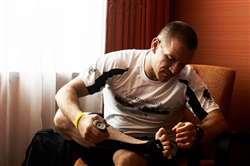 PHOTO: Air Force Master Sgt. Donald Stichter prepares his feet prior to the start of the ING Luxembourg Night Marathon, May 31, 2014. U.S. Air Force photo by Senior Airman Rusty FrankSPANGDAHLEM AIR BASE, Germany– Some people hope that when they compete in a marathon they can finish it in one piece. Stichter trained for more than five months to get ready for the race. "I would like to finish it, potentially without stopping," said Air Force Master Sgt. Donald Stichter, 52nd Equipment Maintenance Squadron noncommissioned officer in charge of munitions inspection. "Even if I stop, I will be happy just to finish it alive." Starting at sunset May 31, more than 9,000 people ran in the ING Luxembourg Night Marathon. Before that race, Stichter said, he never had a desire to run in a marathon. However, after his commander heard the Lakewood, Colorado, native had completed a Tough Mudder -- a 10-to-12-mile series of obstacle courses -- he asked Stichter why he’d never attempted a 26.2-mile marathon. Thinking that he was going to be smarter than his commander, Stichter said, he made him an offer: if he completed a full marathon, his commander would have to do a Tough Mudder.
PHOTO: Air Force Master Sgt. Donald Stichter prepares his feet prior to the start of the ING Luxembourg Night Marathon, May 31, 2014. U.S. Air Force photo by Senior Airman Rusty FrankSPANGDAHLEM AIR BASE, Germany– Some people hope that when they compete in a marathon they can finish it in one piece. Stichter trained for more than five months to get ready for the race. "I would like to finish it, potentially without stopping," said Air Force Master Sgt. Donald Stichter, 52nd Equipment Maintenance Squadron noncommissioned officer in charge of munitions inspection. "Even if I stop, I will be happy just to finish it alive." Starting at sunset May 31, more than 9,000 people ran in the ING Luxembourg Night Marathon. Before that race, Stichter said, he never had a desire to run in a marathon. However, after his commander heard the Lakewood, Colorado, native had completed a Tough Mudder -- a 10-to-12-mile series of obstacle courses -- he asked Stichter why he’d never attempted a 26.2-mile marathon. Thinking that he was going to be smarter than his commander, Stichter said, he made him an offer: if he completed a full marathon, his commander would have to do a Tough Mudder.
Fully expecting his commander would decline, he added, he was surprised when his boss called his bluff. After the deal was sealed, the training commenced. Stichter relied on the four pillars of the Comprehensive Airman Fitness concept to help train for the marathon. For the social part, Stichter ventured outside family zones by going on group runs with people he wouldn't normally meet. "I think the social aspect of going out and running with guys and girls who are training with me for the marathon has been a lot of fun -- a little bit of bonding," he said. With the physical pillar, Stichter noticed he could work out longer with an even higher intensity. He also noticed that the mental and physical pillars tied together.
Read more: Meet Your Military: Airman Competes in First Marathon
- Details
- Hits: 2370
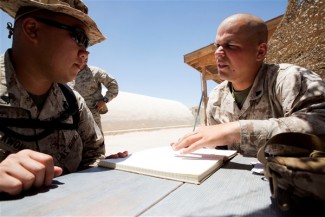 PHOTO: Marine Corps Cpl. Michael Kean, right, discusses the instructions for the day with a fellow Marine during a desert training exercise, June 16, 2014. U.S. Marine Corps photo by Sgt. Adwin EstersMARINE CORPS AIR GROUND COMBAT CENTER TWENTYNINE PALMS, Calif. – From a very young age, Marine Corps Cpl. Michael Kean said, he knew he wanted to lead Marines, because the core values the Marines stand for -- honor, courage, and commitment -- were traits he wanted to emulate. “I’ve known I wanted to be a Marine since I was 6 years old,” the Crossville, Tennessee, native said. Kean said he never had a stable father figure while he was growing up, and that he realized that joining the Marines could enable him to be the role model he never had for junior Marines under his care. He enlisted at age 21 and served as a landing support specialist with Combat Logistics Regiment 45 out of Marietta, Georgia. Waiting a couple of years after high school, he said, gave him life experience that seemed to pay off in his leadership skills.
PHOTO: Marine Corps Cpl. Michael Kean, right, discusses the instructions for the day with a fellow Marine during a desert training exercise, June 16, 2014. U.S. Marine Corps photo by Sgt. Adwin EstersMARINE CORPS AIR GROUND COMBAT CENTER TWENTYNINE PALMS, Calif. – From a very young age, Marine Corps Cpl. Michael Kean said, he knew he wanted to lead Marines, because the core values the Marines stand for -- honor, courage, and commitment -- were traits he wanted to emulate. “I’ve known I wanted to be a Marine since I was 6 years old,” the Crossville, Tennessee, native said. Kean said he never had a stable father figure while he was growing up, and that he realized that joining the Marines could enable him to be the role model he never had for junior Marines under his care. He enlisted at age 21 and served as a landing support specialist with Combat Logistics Regiment 45 out of Marietta, Georgia. Waiting a couple of years after high school, he said, gave him life experience that seemed to pay off in his leadership skills.
“He’s an outstanding Marine,” said Marine Corps Gunnery Sgt. Khoa Truong, a supply staff noncommissioned officer who has worked closely with Kean during Integrated Training Exercise 4-14, an annual desert training exercise. “He does nothing but drive above and beyond his required duty and has been filling the role of someone above his rank. He gives me 100 percent every day.” Truong said he noticed Kean’s ability to tackle problems better than most corporals in his situation. “I like it. I work better under stress,” Kean said. Kean is a busy man. He and his wife of two years have a 6-year-old son and an 8-month-old daughter.
Read more: Meet Your Military: Corporal Follows Dream of Leading Marines
- Details
- Hits: 2462
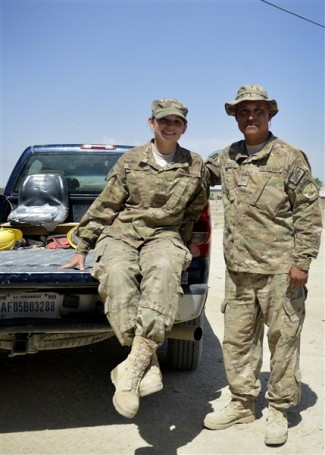 PHOTO: Air Force Senior Airman Kimberly Buzzell, left, and her father, Air Force Tech. Sgt. John Trujillo, pose for a photograph at Bagram Airfield, Afghanistan, July 1, 2014. U.S. Air Force photo by Staff Sgt. Evelyn ChavezBAGRAM AIRFIELD, Afghanistan – The military becomes a tightly knit family for people who are away from home. Service members share many unique experiences, and when the time comes to deploy, they need “family” support that much more. Both are assigned to Task Force Signal and deployed from the Air National Guard’s 243rd Engineering Installation Squadron in South Portland, Maine. For Air Force Tech. Sgt. John Trujillo and Air Force Senior Airman Kimberly Buzzell, the support network is available not only from their unit, but also each other, as this father and daughter share their first deployment together here. Trujillo and Buzzell are both deployed from the Air National Guard’s 243rd Engineering Installation Squadron in South Portland, Maine, and are natives of Turner, Maine.
PHOTO: Air Force Senior Airman Kimberly Buzzell, left, and her father, Air Force Tech. Sgt. John Trujillo, pose for a photograph at Bagram Airfield, Afghanistan, July 1, 2014. U.S. Air Force photo by Staff Sgt. Evelyn ChavezBAGRAM AIRFIELD, Afghanistan – The military becomes a tightly knit family for people who are away from home. Service members share many unique experiences, and when the time comes to deploy, they need “family” support that much more. Both are assigned to Task Force Signal and deployed from the Air National Guard’s 243rd Engineering Installation Squadron in South Portland, Maine. For Air Force Tech. Sgt. John Trujillo and Air Force Senior Airman Kimberly Buzzell, the support network is available not only from their unit, but also each other, as this father and daughter share their first deployment together here. Trujillo and Buzzell are both deployed from the Air National Guard’s 243rd Engineering Installation Squadron in South Portland, Maine, and are natives of Turner, Maine.
Trujillo, a cable antenna team chief, has served for 26 years. Buzzell has been in the Air Force for five years and is a radio frequency transmissions technician. Both are deployed with Task Force Signal. For them, the Air Force, deployments and moving always have been a normal way of life. “My wife retired from active duty about nine years ago,” Trujillo said. “We have traveled and lived everywhere, and now that my daughter is older, I think she appreciates the opportunities we had being a military family.” Five years ago while Trujillo was deployed to Afghanistan, Buzzell enlisted in the same unit as her father. Trujillo came home to the surprise that his daughter was in the Air Force and part of his unit. “My dad had mentioned the military, and I always wanted to join,” she said. “Other plans happened. I got married and had kids, so a few years later, I just decided to join.” Though he was surprised, Trujillo said, he was proud of his daughter. “I never pushed her to join. I would have supported her in any decision she made,” he added. “I always thought that the Air Force would be a good choice for her. I think the Air Force is very family oriented, and it helps give you an idea of what you want to do with your life.”
Read more: Meet Your Military: Father, Daughter Share Afghanistan Deployment






